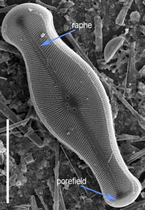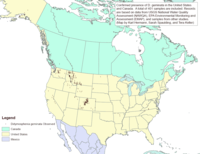Didymosphenia geminata: Difference between revisions
m r2.5.2) (robot Adding: de:Didymosphenia geminata |
Jboltonnal (talk | contribs) |
||
| Line 104: | Line 104: | ||
*{{ITIS |id=590824 |taxon=Didymosphenia geminata |accessdate=17 July 2007}} |
*{{ITIS |id=590824 |taxon=Didymosphenia geminata |accessdate=17 July 2007}} |
||
*[http://cisr.ucr.edu/didymo_rock_snot.html CISR: Rock Snot] - information on ''Didymosphenia geminata'' from the Center for Invasive Species Research |
*[http://cisr.ucr.edu/didymo_rock_snot.html CISR: Rock Snot] - information on ''Didymosphenia geminata'' from the Center for Invasive Species Research |
||
* [http://www.invasivespeciesinfo.gov/aquatics/didymo.shtml Species Profile- Didymo (''Didymosphenia geminata '')], National Invasive Species Information Center, [[United States National Agricultural Library]]. Lists general information and resources for Didymo. |
|||
[[Category:Diatoms]] |
[[Category:Diatoms]] |
||
Revision as of 14:44, 16 February 2011
| Didymosphenia geminata | |
|---|---|

| |
| Didymo found beside the Mararoa River in New Zealand. | |
| Scientific classification | |
| Domain: | |
| Kingdom: | |
| Phylum: | |
| Class: | |
| Order: | |
| Family: | |
| Genus: | |
| Species: | D. geminata
|
| Binomial name | |
| Didymosphenia geminata (Lyngbye) M. Schmidt, 1899
| |
| Synonyms | |
| |
Didymosphenia geminata, commonly known as didymo or rock snot, is a species of diatom that grows in warm and shallow water. If it overgrows, it can form large mats on the bottom of lakes, rivers and streams. It is not considered a significant human health risk, but it can affect stream habitats and sources of food for fish and make recreational activities unpleasant. It is considered a nuisance organism or invasive species. The microscopic algae can be spread in a single drop of water.
Cell biology

Didymosphenia geminata is a diatom, which is a type of single-celled algae unique for their silica (SiO2) cell walls. The life history of diatoms includes both vegetative and sexual reproduction, though the sexual stage is not yet documented in this species. Although it is symmetric only along the apical axis, typical of gomphonemoid diatoms, it is a cymbelloid, which are typically symmetric along both primary axes. Cells contain a raphe, which allows them to move on surfaces, and an apical porefield, through which a mucopolysaccharide stalk is secreted.
The stalk can attach to rocks, plants, or other submerged surfaces. When the diatom cell divides, through vegetative reproduction, the stalk divides too, eventually forming a mass of branching stalks. The nuisance build-up is not the cell itself, but their massive production of extracellular stalks. Extracellular polymeric substances (EPS) that form the stalks are made primarily of polysaccharides and protein, forming complex, multi-layered structures that are resistant to degradation.[1]
Native range
The native distribution of D. geminata is the cool temperate regions of the Northern Hemisphere, including the rivers of northern forests and alpine regions of Europe, Asia and parts of North America. Until its recent discovery in New Zealand, where it was introduced, it was never previously found in the Southern Hemisphere. The distribution of didymo in the last two decades appears to be gradually expanding outside its native range. Even within its native range, there have been reports of excessive growths in areas where it previously existed only in low concentrations.[2]
Regions
South America
Chile: The United States Geological Survey [USGS] confirmed the identification of the diatom Didymosphenia geminata ("Didymo") as forming extensive blooms in Chilean rivers near Esquel, in the Chubut Province of Argentina. The bloom was reported [3] on Espolon River and Futaleufú River, for a total of more than 56 river kilometers affected. These two rivers are located in the Los Lagos Region, Region X of Chile, Chiloe District. [4] The result was confirmed by a Chilean laboratory, Centro de Investigacion en Ecosistemas de la Patagonia (CIEP) on 28 May, 2010. [5]
New Zealand

In 2004 D. geminata was discovered in New Zealand, the first time it was found in the southern hemisphere. To restrict its spread, the whole of the South Island of New Zealand was declared a controlled area in December 2005. Extensive publicity was carried out to limit the spread but it was found in an increasing number of rivers.
North America


British Columbia: Didymosphenia geminata was first reported as a nuisance species in the late 1980s on Vancouver Island. Since that time, outbreaks of Didymo have been reported on the island and on the mainland.
Alberta: Earliest anecdotal reports of Didymosphenia geminata blooms in Alberta rivers occurred as early as the mid-1990s (e.g. the upper Bow River in Banff National Park). Reports of Didymo presence and bloom formation have been documented for most rivers in the South Saskatchewan River Basin in recent years (2005 to current).
South Dakota: It has been present in Rapid Creek in South Dakota since at least 2005, and is blamed for a significant decline in the brown trout population. It is also present to lesser extents in other nearby locations.[7]
Tennessee: Didymo was found in the tailwaters of the Norris, Cherokee, Wilbur and South Holston hydroelectric dams in 2005. It is the first U.S. finding east of the Mississippi River.[8]
Virginia: Didymo was identified in western Virginia in the summer of 2006 in the Smith River, the Jackson River, and the Pound River.[9]
Vermont: In June 2007, didymo was discovered in the Connecticut River, near Bloomfield, Vermont, its first recorded discovery in the northeastern United States. The sighting was reported by a fishing guide and confirmed by Dr. Sarah Spaulding, a didymo expert from Denver, Colorado.[10]
New Hampshire: Also during the summer of 2007, didymo was discovered for the first time in New Hampshire in the Connecticut River near Pittsburg.[11]
New York: In August 2007, didymo was first discovered in New York State in a section of the Batten Kill in Washington County.[12] It has also been found in Esopus Creek in the Catskills.
Maryland: In May 2008, didymo was found in the Gunpowder River in Baltimore County.[13]
Preventing the spread
The following methods have been recommended to prevent the spread of didymo in New Zealand:
Check: Before leaving the river, remove all obvious clumps of algae and look for hidden clumps. Leave them at the site. If you find clumps later don't wash them down the drain, treat them with the approved methods below, dry them and put them in a rubbish bin.
Clean: Soak and scrub all items for at least one minute in either hot (60°C) water, a 2% solution of household bleach or a 5% solution of salt, antiseptic hand cleaner or dishwashing detergent.
Dry: If cleaning is not practical (e.g. livestock, pets), after the item is completely dry wait an additional 48 hours before contact or use in any other waterway.
New Zealand and the U.S. states of Alaska and Vermont have banned anglers from wearing felt-soled boots. Maryland is considering doing so as well. Orvis, a leading U.S. manufacturer of fly-fishing equipment, has started selling more rubber-soled boots than felt-soled.[14]
References
- ^ a b Spaulding, Sarah (2007). "Increase in nuisance blooms and geographic expansion of the freshwater diatom Didymosphenia geminata (White paper)" (PDF). United States Environmental Protection Agency. Retrieved 2007-07-31.
{{cite web}}: Unknown parameter|coauthors=ignored (|author=suggested) (help); Unknown parameter|month=ignored (help) - ^ Biosecurity New Zealand (2007). "FAQs about Didymo". Biosecurity New Zealand. Retrieved 2007-08-25.
{{cite web}}: Cite has empty unknown parameter:|coauthors=(help); Unknown parameter|month=ignored (help) - ^ Invasive Algae Species Discovered In Chile’s Patagonia Region. The Santiago Times. Retrieved on 2010-06-01.
- ^ Didymo Identified in Chile.. United States Geological Survey (USGS). Retrieved on 2010-05-17.
- ^ Se Identifica Presencia de Alga Invasora Didymo en Rio Futaleufu.. Centro de Investigacion en Ecosistemas de la Patagonia (CIEP). Retrieved on 2010-05-31.
- ^ Distribution map - Confirmed presence of D. geminata in the United States and Canada. U.S. Environmental Protection Agency. Retrieved on 2007-07-16.
- ^ Game, Fish and Parks news releases for July 14, 2006 South Dakota Game, Fish and Parks. 2006-07-14. Retrieved on 2007-07-16.
- ^ Schroeder, Owen. Invasive algae 'Didymo' found in Tennessee River. Tennessee Wildlife Resources Agency. 2005-09-01. Retrieved on 2007-07-16.
- ^ Didymo (Invasive Freshwater Algae) in Virginia. Virginia Department of Game and Inland Fisheries. Retrieved on 2008-10-13.
- ^ ANR Confirms First Northeastern U.S. Infestation of "Didymo". (Press release). Vermont Agency of Natural Resources. 2007-07-06. Retrieved on 2007-07-16.
- ^ FAQs about Rock Snot in New Hampshire. New Hampshire Department of Environmental Services. Retrieved on 2008-10-13.
- ^ NYSDEC Announces Didymo Found in Lower Section of Batten Kill. (Press release). New York State Department of Environmental Conservation. 2007-08-07. Retrieved on 2008-10-13.
- ^ Invasive Algae Found In Maryland. Maryland Department of Natural Resources. 2008-05-08. Retrieved on 2008-09-21.
- ^ Barringer, Felicity (August 15, 2010). "Fly Fishers Serving as Transports for Noxious Little Invaders". The New York Times. Retrieved August 17, 2010.
External links
- AlgaeBase - taxonomic and nomenclatural information
- "Didymosphenia geminata". Integrated Taxonomic Information System. Retrieved 17 July 2007.
- CISR: Rock Snot - information on Didymosphenia geminata from the Center for Invasive Species Research
- Species Profile- Didymo (Didymosphenia geminata ), National Invasive Species Information Center, United States National Agricultural Library. Lists general information and resources for Didymo.
